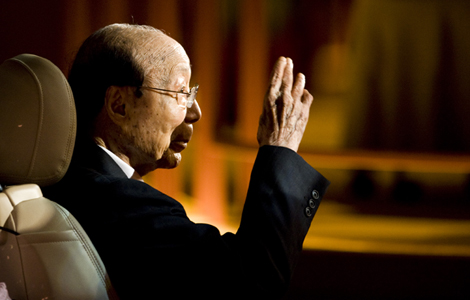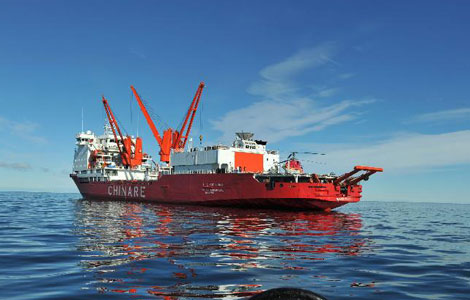FAO, China celebrate 40th anniversary of partnership
Updated: 2014-01-15 17:27
(chinadaily.com.cn)
|
|||||||||||
In 1973 the People's Republic of China resumed its membership of the Food and Agriculture Organization of the United Nations (FAO). This was the beginning of a forty-year long partnership that has consistently made tremendous achievements in a wide range of sectors including agriculture, forestry, fisheries, environmental sustainability and preparedness to responding to climate change and emergencies.
Throughout these years of collaboration, FAO has proudly witnessed China's impressive accomplishment in feeding 22 percent of the world's population with only 9 percent of the arable land and 6 percent of the freshwater. FAO accompanied China in this path by providing technical support to over 400 field projects in priority agriculture development areas that has targeted tens of millions of beneficiaries across this vast and diverse country.
For instance, since 1981 the FAO Investment Centre has supported China in the preparation and review of agriculture and rural sector investment projects, which has led to investments of over USD 8.3 billion. Since 2008 FAO has assisted the Government of China in preparing and implementing projects financed by the Global Environmental Facility (GEF) amounting to USD 27.3 million in secured GEF financing.
Recent support has included extensive joint work on legal aspects of land, water and natural resources for integrating land policy reforms in China, and on irrigated agricultural production intensification, both in collaboration with the World Bank.
With respect to emergencies and preparedness, a remarkable result was achieved tackling the Avian Influenza outbreak in 2004 which was a major concern to the international community. This has prompted the creation of successful surveillance activities which have contributed to containing similar incidents, such as the virus H7N9.
Among joint achievements of the China-FAO-GEF partnership is the "Conservation and Adaptive Management of Globally Important Agricultural Heritage Systems (GIAHS)" project which has achieved great results in China in terms of establishing a national system for certification and support to GIAHS sites playing a multiple role of providing food security, conservation of agrobiodiversity and unique indigenous knowledge.
It is exciting for FAO to witness how China has moved from being a recipient country to becoming a major provider of technical assistance and other development solutions to many nations of the global South. China and FAO recognize the importance of South-South Cooperation (SSC) in addressing world food insecurity through the exchange of knowledge, technologies and experiences with less developed countries.
As part of its efforts to address food insecurity and hunger in less developed countries, in 2008 the Government of China established a USD 30 million Trust Fund in FAO to support the SSC Programme under the FAO/South-South Cooperation Framework. Through this pioneer model of SSC initiative, the China-FAO partnership has moved to a new stage, transforming livelihoods in some 24 countries where nearly 1 000 Chinese experts and technicians have been deployed in the last decade in Africa, Asia, the Caribbean and the South Pacific.
These experts deployed for periods of two to three years have been sharing and imparting knowledge and experience to farmers, extension workers and local institutions to effectively transfer appropriate technologies to developing countries. In Nigeria, improved technologies in rice production, irrigation and aquaculture have become a significant aspect of the successful Agricultural Transformation Agenda (ATA) of the country, and are transforming lives of tens of thousands of farmers in 36 states of Nigeria.
In Malawi, over 200 improved crop varieties were introduced and over 10 000 extension workers and farmers were trained by Chinese experts. In Senegal, rice production has significantly increased through the technologies introduced by Chinese experts. In Mongolia, intensive farming technologies introduced by Chinese experts are yielding quick results for improved crops and livestock production under extreme climatic conditions. More recently, under the FAO-China SSC Programme, several training courses and study tours have been organized in China for technicians and policy-makers from hosting countries. China also supported the launching of the workshop on Tropical Agriculture Platform (TAP) and international training on responsible aquaculture and fisheries.
Achievements and technical solutions disseminated through the FAO-China partnership have been regularly showcased at the Global South-South Development (GSSD) Expos which took place in Rome (2011), Vienna (2012) and Nairobi (2013). At a High-Level Forum on SSC in Abuja, Nigeria, in September 2013, organized to review the achievement and lessons from SSC in Africa, China's contribution and huge potential as an SSC provider was highlighted in the Abuja Declaration in which delegates from 12 African countries, Brazil, China, and Viet Nam pledged to work together on SSC, to share experiences, knowledge, technologies, best practices and capacities, as well as explore new areas and modalities of multilateral agricultural SSC.
Building on the successes and experiences learned from the FAO-China SSC programme, a new five-year FAO-China Cooperation Programme has been developed to cover five priority areas of collaboration between China and FAO, both in the country and outside China, with a strong focus on SSC as the main delivery mechanism. The five priority areas include up-scaling the impact of SSC on food security and nutrition; quality-assured production of veterinary vaccines for Africa; strengthening and networking agricultural research and training centres both in China and Africa; and development of aquaculture and renewable energy development and agri-ecosystems protection.
The partnership between China and FAO has an immense potential to address development challenges and significantly contribute to the post-2015 development agenda, thereby providing a beacon of hope to many developing countries.
Authors:
Laurent Thomas, Assistant Director-General, Technical Cooperation Department, FAO
Jong-Jin Kim, Director, South-South and Resource Mobilization Division, FAO
Today's Top News
UK dumps Chinese telecom equipment
At least 16 dead in E China factory fire
Hollande responds to affairs reports
Li offers Bulgaria help with big projects
Xi calls for reform to fight graft
China, Italy agree to boost co-op
S. China Sea rules no threat to peace
Park urges Japan to face history
Hot Topics
Lunar probe , China growth forecasts, Emission rules get tougher, China seen through 'colored lens', International board,
Editor's Picks

|

|

|

|

|

|





